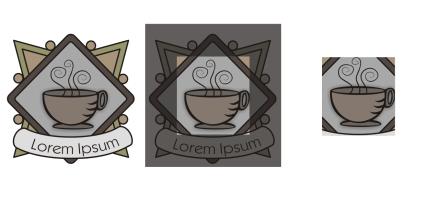
| • | To crop objects |
| • | To split an object |
| • | To erase portions of an object |
| • | To delete a virtual line segment |
You can crop, split, and erase portions of objects.
You can split a bitmap or vector object in two and reshape it by redrawing its path. You can split a closed object along a straight or jagged line. CorelDRAW lets you choose between splitting an object into two objects, or leaving it as one object composed of two or more subpaths. You can specify whether you want to close paths automatically or keep them open.
From left to right: The Knife tool creates two separate objects from the green rectangle. Then, the two objects are moved into an unfilled black object to create an envelope.
CorelDRAW lets you erase unwanted portions of bitmaps and vector objects. The Eraser tool works just like a pencil eraser, removing any part of the image over which you click and drag. Erasing automatically closes any affected paths and converts the object to curves. If you erase connecting lines, CorelDRAW creates subpaths rather than individual objects.
| To crop objects |
|
| 1 . | Select the objects that you want to crop. |
| If no objects on the drawing page are selected, all objects will be cropped. |
| 2 . | In the toolbox, click the Crop tool |
| 3 . | Drag to define a cropping area. |
| 4 . | Double-click inside the cropping area. |
|
Type values in the Crop position boxes on the property bar, and press Enter.
|
|
|
Type values in the Crop size boxes on the property bar, and press Enter.
|
|
|
Type values in the Angle of rotation box.
|
|
|
Click the Clear crop marquee button.
|
Objects on locked, hidden, Grid, or Guides layers cannot be cropped. Also, you cannot crop OLE and Internet objects, rollovers, or the content of PowerClip objects.
During cropping, affected linked groups, such as contours, blends, and extrusions, are automatically broken apart.
You can remove the cropping area by pressing Esc.
| To split an object |
|
| 1 . | In the toolbox, click the Knife tool |
| 2 . | Position the Knife tool over the object’s outline where you want to start cutting. |
| The Knife tool snaps upright when positioned properly. |
| 3 . | Click the outline to start cutting. |
| 4 . | Position the Knife tool over the object’s outline where you want to stop cutting, and click again. |
|
Hold down Shift, click where you want to start cutting an object, drag the control handle to where you want to position the next node, and click. Continue clicking to add more straight segments to the line. If you want to add a curved segment, point to where you want to place the node and drag to shape the curve. If you want to constrain the line by 15-degree increments, hold down Shift + Ctrl.
|
|
|
Click the Keep as one object button
|
|
|
Click the object’s outline where you want to start the cut, and point to where you want the cut to end. Press Tab once or twice until only the part of the object that you want to keep is selected, and then click.
|
By default, objects are split into two objects and paths are automatically closed.
When you use the Knife tool on a selected object, the object becomes a curve object.
| To erase portions of an object |
|
| 1 . | Select an object. |
| 2 . | In the toolbox, click the Eraser tool |
| 3 . | Drag over the object. |
|
Type a value in the Nib size box on the property bar, and press Enter.
|
|
|
Click the Round nib or the Square nib button on the property bar.
|
|
|
Disable the Reduce nodes button on the property bar.
|
When you erase portions of objects, any affected paths are automatically closed.
You can erase straight lines by clicking where you want to start erasing, and then clicking where you want to finish erasing. Press Ctrl if you want to constrain the line’s angle.
You can also erase an area of a selected object by double-clicking the area with the Eraser tool.
| To delete a virtual line segment |
|
| 1 . | In the toolbox, click the Virtual segment delete tool |
| 2 . | Move the pointer to the line segment you want to delete. |
| The Virtual segment delete tool snaps upright when positioned properly. |
| 3 . | Click the line segment. |
| If you want to delete multiple line segments at one time, click the pointer to drag a marquee around all line segments you want to delete. |
|
Hold down Alt, and drag to draw a curve.
|
|
|
Hold down Shift, click the two overlapping end points. You can also hold down Alt + Shift, and drag to marquee select the overlapping nodes.
|
The Virtual segment delete tool does not work on linked groups such as drop shadows, text, or images.
Deleting virtual line segments
Copyright 2015 Corel Corporation. All rights reserved.